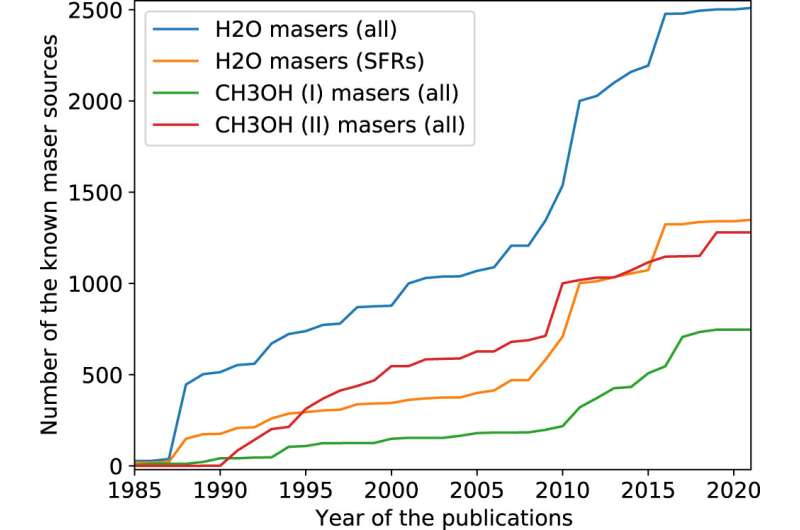Scientists created complete online database of water masers

Scientists from Ural Federal University, the Physical Institute of the Russian Academy of Sciences (Moscow), and the Joint Institute for VLBI ERIC (the Netherlands) have created the most comprehensive and convenient online database of water masers, the cosmic sources of microwave radiation. This will allow discovering new patterns of star formation regions, identifying and investigating the most promising objects in our galaxy. An article describing the database was published in The Astronomical Journal.
Masers in star-forming areas (mainly of three types: water, methanol, and hydroxyl) are frequently encountered in our galaxy, and they are variable: their emission is brighter, then weaker. Therefore, studies of masers require reference to data on their former state, while the volumes of information are growing at a great speed.
"Our database of water masers in the Galaxy is the most substantial. It covers 95% of all observations of water masers in star-forming areas, published since 1989, and almost 100% of the sources. The database is constantly being updated and will soon concentrate all the information on water masers in star-forming areas. The database contains full observational characteristics of masers: position, radiant velocity, emission intensity and other," says Dmitry Ladeishchikov, the project manager and senior researcher at the Kourovka Astronomical Observatory of the Ural Federal University.
As source material, the developers used data from more than 140 articles, from which they extracted not only numerical data, but also images (spectra) and text descriptions of maser sources. The researchers divided the article into several categories: general maser studies, maser variability studies, maser flare studies, etc. In addition, data in the infrared, millimeter and other wavelength ranges are made available through the database. This is especially important for a comprehensive study of maser sources.
The database is equipped with technological solutions for selecting sources, presenting information online. New data is entered semi-automatically with the support of a specialized information system created by Dmitry Ladeishchikov.
"In this way the database opens up the possibility of quick and convenient access to almost the entire corpus of observational archives. Previously, maser researchers had to find and analyze a large amount of heterogeneous data scattered in different articles on their own. Now the comprehensive information is systematized and the search process takes a few seconds. This makes it much faster to analyze the data and draw conclusions from it," says Ladeishchikov.
The database on water masers is part of a large project that has been underway at the Kourovka Astronomical Observatory for the past five years. The goal of the project is to accumulate comprehensive data on observed masers of all types. Previous work performed by Ural Federal University astronomers was devoted to creating a similar database on methanol masers, as well as on masers in circumstellar sources. There are plans to create a database on hydroxyl masers. According to Dmitry Ladeishchikov, statistical analysis of the information collected, including machine learning methods, will make it possible to predict the location of previously unknown masers and effectively plan future observations.
Based on the previously created database on methanol masers and comparing them with water masers, scientists at the Kourovka Astronomical Observatory at UrFU confirmed that water masers are among the earliest indicators of star formation processes.
Masers are sources of microwave radiation, much more powerful than that from stars. Therefore, by targeting masers, scientists can explore distant parts of space.
For example, the emission of masers in the water vapor line indicates active star formation processes. In addition, the emission of such masers is detected in the disks of pro-evolved stars, as well as in the outer galaxies. Water masers are formed in shock waves at high gas temperatures and densities, and can be associated with both massive and low-massive objects.
Water masers in star formation areas are the most common type of water masers. Of the 2,600 water masers known to science, about 1,600 belong to this type of water masers. According to estimates by scientists at the Kourovka Astronomical Observatory, there are about 3,000 star-forming areas in the Milky Way galaxy with a high probability of detecting a water maser. Thus, in the future, it is possible to detect about 1,400 objects with maser emission in the water vapor line in the star formation areas.
The leader in the number of known maser objects is the group of hydroxyl masers (about 3,000). The total number of galactic maser sources of different types known at the moment is about 8,000.
More information: Dmitry A. Ladeyschikov et al, Online Database of Multiwavelength Water Masers in Galactic Star-forming Regions, The Astronomical Journal (2022). DOI: 10.3847/1538-3881/ac480f
Database: maserdb.net/
Journal information: Astronomical Journal
Provided by Ural Federal University





















